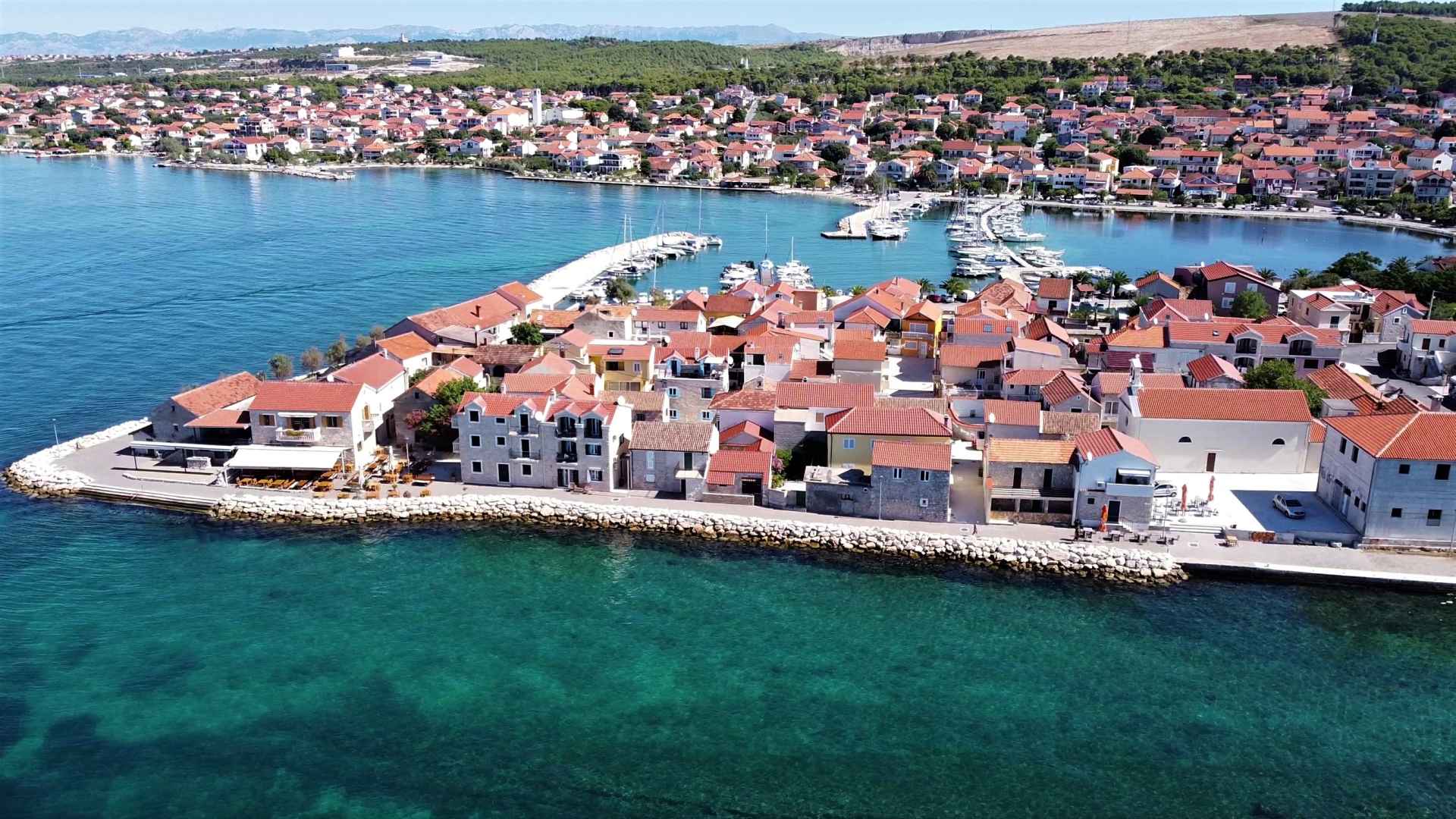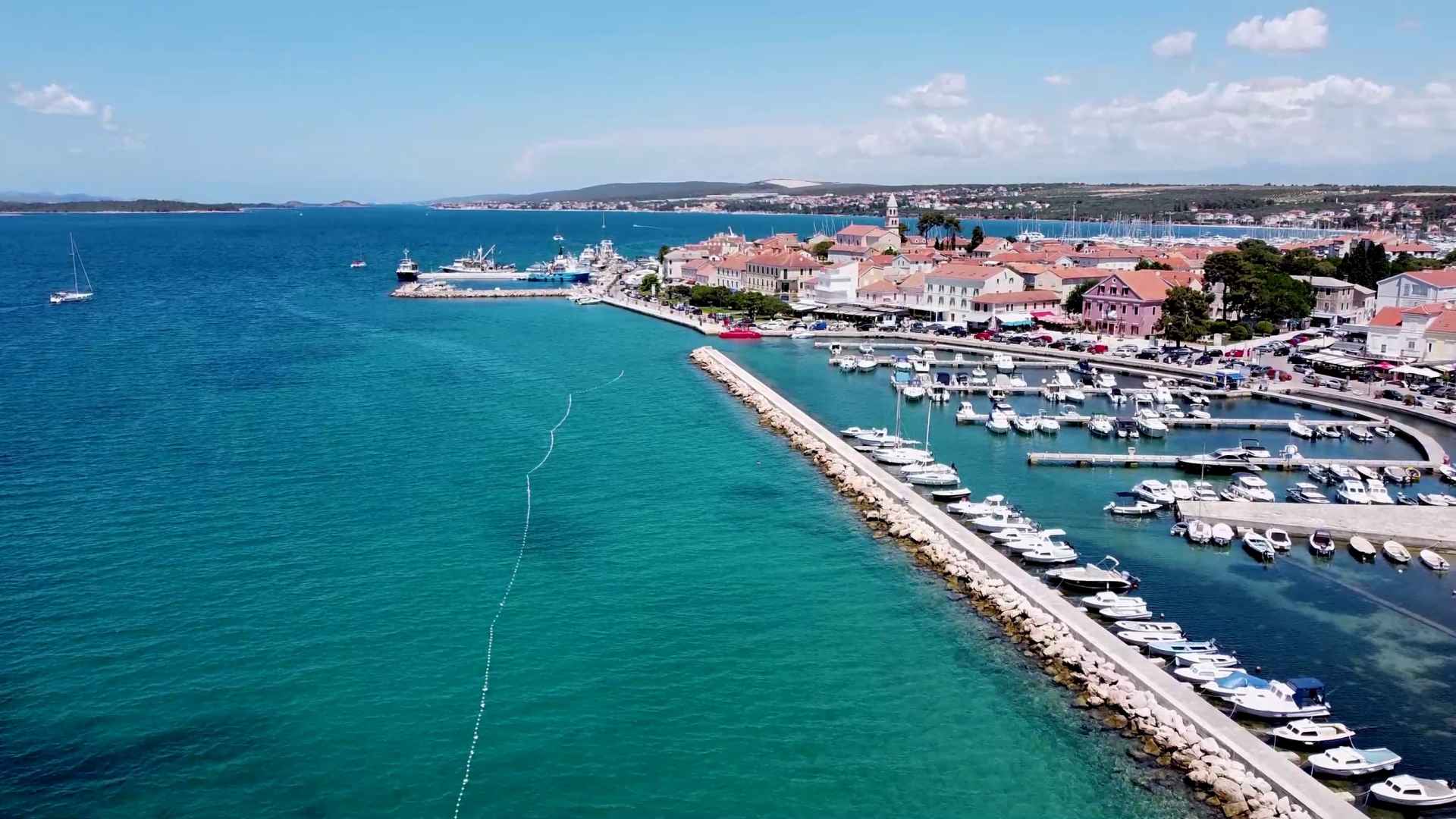Private accommodation Zadar - Dalmatia Apartments and holiday homes with direct contact! No fees and commissions!
Popular tourist places
Top destinations in Zadar - Dalmatia
Discover Zadar - Dalmatia
Tourist guide Zadar - Dalmatia

Zadar- sun over the sea! Famous director Alfred Hitchcock said about Zadar that "Zadar has the most beautiful sunset in the world"! How can we contradict the legendary master of a film camera but yet the right way to check his words is just one, and that is to visit this wonderful Dalmatian city!
Its history is truly ancient and dates back to the early Stone Age, and the name of the city "Jader" probably originates from the pre-Eastern European language of its ancient Mediterranean settlers. After the Illyrian tribes of Liburni, the town in the 2nd century BC was inhabited by the Romans and the colony of Roman citizens. Judging by the name of "Colonia Julia Jader", 48th pr. Cr. Zadar was most probably founded by Julius Caesar. After the fall of the Roman Empire, Zadar is under the rule of Byzantium, when assumed the role of the capital of Dalmatia, which will remain until 1918. In the Middle Ages Zadar was under the rule of Croatian kings. After the end of Croatian kingdom, it was part Hungary and then under long Venetian domination. In the history of the city, the tragedy of the siege of 1202 is emphasized, when the Venetians used crusaders to destroy, demolish and plunder Zadar. In the 19th century, Zadar came under the Austrian rule under which it remained until the end of the Second World War.
Through all these historical turmoil, Zadar grew up as a city and a cultural center, with impressive city walls built in the 15th and 16th centuries that made Zadar the largest fortress in the Venetian Republic. Today city walls give Zadar irresistible charm and make a big part of rich tourist offer. In addition to the walls, there is also the church of St. Donat, the most valuable monument of pre-Romanesque early Middle Ages built in Croatia. It was built in the 9th century. In addition to that, you can also visit the cathedral of St. Stošija, but also the unavoidable and unique sea organ, a unique blend of architecture, nature, and music. Sea organ is built on the 75 meters long coastline and their specialty is that the sound is not generated by the circulation of air but by the waves of the Zadar waterfront. It gives a unique possibility to hear how is singing Adriatic sea!
And for the end of Zadar story - Greetings to the sun! The most beautiful sunset in the world deserved a place worthy of attention, and this is the architectural-artistic installation of Nikola Bašić, located on the western point of the Zadar peninsula right next to the Sea Organ. Greetings to the Sun consists of three hundred multilayer glass panels placed on the same level on a rocky pavement of 22m in diameter. Sun and other planets of the sun are proportionately placed. As the Sea Organ is a sounding part of the story of Zadar's sunset, Greetings to the sun is a visual part that together makes a unique experience!
Close to Zadar is the unavoidable Croatian destination for young people who are looking for thrilling nightlife - the island of Pag. Popular beach Zrće has gained cult status so far, but Pag is far more than that. The island of serene but surreal beauty, almost moonlike landscape on the Velebit side is the place where the best Croatian lamb is grown and where the best Croatian cheese is made! In the vicinity of Zadar there is also the town of Biograd Na Moru, the seat of Croatian kings and bishops, and today the tourist center. Town of Nin is also the center of Croatian medieval kings. Here is the Church of St. Cross, known as the smallest cathedral in the world, which was built in the 9th century.
For all nature lovers and active vacationers near Zadar are Starigrad Paklenica and National Park Paklenica, where you can enjoy alpinism, hiking and clean air of the mighty mountain Velebit. At the foot of Velebit, you will find the karst beauty, river Zrmanja, which will charm you with its beauty and emerald watercolor, where you can spend a day on a kayak, raft or swimming. Nearby is the largest freshwater lake in Croatia, Lake Vrana. Because of its exceptional natural beauty and richness of flora and fauna has been proclaimed a Nature Park. Here you can spend a day walking, cycling or sports fishing. Above the lake, there is a beautiful viewpoint from where you can see the entire Zadar archipelago. From the islands in the Zadar archipelago, with its beauty and beautiful beaches, we can highlight Ugljan, Pašman, Silba and Dugi Otok. All of them are connected by ferry lines from the city of Zadar.
How to get to all these Zadar miracles? Quite simply, given that Zadar is well connected with modern highway and the airport that make it easy to reach. The city and its surroundings are full of holiday homes, beachfront apartments, and rental rooms. Whether you want to stay in hotels or looking for cheaper private accommodation, for example in cheap rooms, cozy apartments or luxurious holiday homes, it is possible to find your ideal accommodation without an agency fee via direct contact with owners of private accommodation. Welcome to Zadar and north part of Dalmatia!
Interesting places
Top tourist attractions Zadar - Dalmatia
Recommendations
What to visit, see and do?

Over the last ten years, Zadar has become one of the pearls of Croatian tourism, due to the exceptionally rich cultural and historical heritage. For many centuries the symbol of Zadar was St Donat church, a monument of pre-Romanesque architecture dating from the 9th century. Apart from the church, there are other symbols such as Roman Forum, Kalelarga, Square of Five Wells (Trg pet bunara) and Prince's Palace (Kneževa palača). However, today the situation is somewhat different because all the attention of Zadar's visitors is attracted by the well-known Sea Organ (Morske orgulje) and Greetings to the Sun (Pozdrav Suncu).
The Sea Organ in Zadar was presented in April 2005 as part of a project of rebuilding the western part of the Zadar peninsula. This truly unique, seventy meters long architectural achievement recognizable by its cascading profile, is a mix of music and architecture. Compared to ordinary organs, music of the Sea Organ is played by the sea and waves. As the sea energy unpredictable, the never-ending concert, whose author is the very nature, is simply unrepeatable.The author of this extraordinary achievement is the Zadar architect Nikola Bašić, who created the Sea Organ with several co-authors. Next to the Sea Organs, there is another unique installation of the same architect that was installed in 2008 - Greetings to the Sun.Greetings to the Sun are three hundred multilayer glass panels arranged in the form of a circle of a total diameter of 22 meters. Below glass conductive boards are photovoltaic solar modules which are the main communication channel with nature. Illumination switches on during the sunset, and in a programmed scenario, illumination plays with lights in the rhythm of the music of the Sea Organs. This unique installation includes Sun and other planets from the solar system.The Sea Organ has been rewarded with numerous awards, of which it is especially worth mentioning the European Award for Public Urban Space in 2006 (CCCB, Barcelona).If you choose to visit these exceptional attractions, we recommend you to find cheap accommodation in rooms, apartments or holiday homes in the city of Zadar.
Because of its unique geomorphological forms and its beautiful forests, the area of Velika Paklenica and Mala Paklenica has been declared national park in 1949, becoming the second national park in Croatia after Plitvice Lakes.
Paklenica National Park covers an area of 96 km2, with its highest peaks being 1757 meters high Vaganski vrh and 1753 meters high Sveto brdo. The area of the park includes areas around the small rivers of Velika Paklenica and Mala Paklenica as well as their vertically engraved canyons on the southern slopes of Velebit. The main characteristics of Paklenica are unspoiled nature, autochthonous pine forests, beech forests, as well as vertical canyons of Velika Paklenica and Mala Paklenica.In July 2017, because of its originality, age and size, about 2030 hectares of original beech forests, located in the area of National Park Paklenica, NP Northern Velebit (Sjeverni Velebit) and nature reserves Hajdučki Kuk and Rožanski kuk nature reserves have entered to UNESCO list of the world's heritage in Europe under the name "Beech Forests of the Carpathians and Other Regions of Europe".Apart from its flora, this national park is also rich with fauna. Around 254 different bird species habitat the area of the national park, of which 112 birds are nesting birds. The most famous ones are eagle, owl, gray hawk, hawk and griffon vulture. The area of the park is also inhabited with roe, deer, chamois, wild pig, bear, wolf, bobcat, and fox.More than 100,000 people a year visit this national park. The majority of them are hikers who visit the Anića kuk, a 712 meters high rock. In the national park, you can also visit one of the caves, of which the most famous ones are the caves Manita peć and Jama Vodarica.Paklenica National Park offers different activities for its visitors, from hiking to rock climbing. An entrance ticket for adults ranges from HRK 40 to HRK 50 (EUR 5 to EUR 7) and is valid for one day. Also, larger groups can visit the park with a tour guide. Accommodation in apartments or rooms can be found in the nearby places such as Starigrad-Paklenica, Tribanj or Rovanjska.
The Zrmanja River starts is in the southern part of Lika below the Poštak Mountain and ends in the Novigrad Sea. The river is navigable for smaller vessels from the Novigrad Sea up to the city of Obrovac, and, because of its less accessibility, Zrmanja is often called a hidden treasure.
After thousands of years of the river flowing towards the sea, river Zrmanja has created an impressive canyon which is considered one of the most beautiful in Croatia. Every year Zrmanja canyon attracts a large number of visitors who enjoy the beauty of the canyon. Numerous waterfalls and strong river rapids on the upper course of the river are characteristics of the typical karst river. Today, the canyon is protected as a significant landscape.One of the most famous waterfalls is Jankovića buk, around which are the remains of old mills. The last 17 kilometers of Zrmanja is navigable for vessels (from Jankovića buk to the Novigrad Sea), and this part of Zrmanja is surrounded by cliffs and specific vegetation for rivers in which river water mixes sea water.The canyon of the Zrmanja River can be explored in different ways, however, each of them includes a vessel. You can either paddle a kayak or canoe (Kaštel Žegarski) or sail on the excursion boat at the lower course of the river. Either way, views of the canyon and nature will simply leave you breathless.The Zrmanja canyon is also well-known for the movie about the fictitious Apache Indian chieftain Winnetou of German writer Karla Maya. For those looking for adventures, there is a rafting tour that lasts for about 4 hours and includes numerous rapids and waterfalls like Ogarov buk as well as a visit to the imposing 13-meter high waterfall Veliki buk (which is bypassed by foot).Zrmanja River Canyon is the ideal destination for families with children because it offers many attractions for kids. If you choose to visit this natural pearl that will surely leave you breathless, you can find affordable accommodation in private apartments in surrounding Obrovac, Karina, Novigrad, Posedarje and other places near Zadar.
Saltern is an industrial process for the production of sea salt, in which in a series of large shallow seawater pools, sea salt is extracted from the water by evaporation. The process itself begins by evaporation in the first pool with the lowest concentration of NaCl and ends in the last pool where the seawater is saturated so the salt is precipitable at the bottom of the pool. The process itself is seasonal, starts in spring and ends in autumn when salt is harvested. Although in the past the salt was harvested at several locations in Croatia, today, only three salterns in Croatia remained – saltern in Ston which is one of the oldest salterns in this part of Europe, saltern in Nin and the largest saltern in Croatia saltern of Pag (Paška solana).
The island of Pag has ideal conditions for sea salt production. Apart from a large number of sunny days, clean environment, favorable wind, rocky and modest vegetation, there is also a millennial tradition of salt production dating back to 999.Saltern of Pag is located to the south of the city of Pag, on the surface of 225 hectares. The saltern also includes pools in Dinjiška, which are connected to the saltern of Pag through the saltwater pipelines. The area of the saltern is surrounded by hills from the east and west sides, while the surface is impermeable and made mostly of clay and loam.Pag salt contains all the minerals that are the constituent parts of the seawater, and its extraordinary quality is confirmed by registering the Pag salt as a source of origin.An interesting fact is that on the island of Pag, the salt had the value of white gold. In the 16th century, the saltern of Pag issued the "Pag assignat" which is considered one of the first forms of paper money in Croatia. The island of Pag offers many possibilities for enjoying ideal holidays. Apart from the saltern of Pag, the island is known for Pag lace and roasted lamb (paška janjetina na ražnju). Those looking for entertainment and nightlife can visit the Croatian beach Zrće, which is located near Novalja. Accommodation in private apartments can be found in the city of Pag in the south of the island or Novalja and the apartment village Gajac in its northern part of the island.
The largest natural lake in Croatia, Vransko lake is located next to Pakoštane, not far from the sea. Since the surface of the lake is above the sea surface (2 meters above the sea level) and the bottom is below (4 meters below the sea level), Vransko Lake is a cryptodepression. Because of the underground reefs and the canal of Prosika through which the lake is connected with the sea, the water in the lake is slightly salty.
Vransko Lake was proclaimed a nature park in 1999 and it is one of eleven nature parks in Croatia. Besides Vransko lake, the park area also includes its surroundings. The nature park covers an area of 57 km2 of which the lake occupies about 30 km2 or more than half of the total park area. The lake is around 14 km long and 1.4 to 3.4 km wide. In 2013, the Vransko Lake Nature Park was listed on the list of protected wetland areas by the Ramsar Convention.The northwestern part of Vransko Lake, which was proclaimed an ornithological reserve in 1983, is considered to be one of the most valuable ornithological areas in the Republic of Croatia. The ornithological reserve area covers an area of less than 9 km2 and represents only the smaller part of the wetland that remained after the wetland area almost completely drained by excavating the canals in the 18th century.The ornithological reserve is certainly one of the most important parts of the park because it is populated by many birds. More than 230 species of birds can be seen in the park, of which about 100 species of birds live there all year long such as swamp birds. Other birds are mostly migratory birds which habitat the area of the park during their migration. In the autumn during the bird migration, biologists estimate that around twenty-two hundred thousand birds a day live in the park. The park is also inhabited with the populations of a dozen endangered species of birds, such as large white heron, small hawthorn, hummingbird and other endangered species.The park visit is free of charge, however, some parts of the park are charged. For more information about the tickets, please visit the official website. Except walking, in the park you can enjoy hiking, biking, kayaking, and other activities. You can also arrange tours with a tour guide or go to school about nature.If you decide to visit this magical place, you can find cheap accommodation in an apartment or holiday home in Pirovac.
On the southeastern part of the island of Dugi otok lies one of the most attractive nature parks in Croatia - Telašćica Nature Park. The center of the park is Telašćica bay, and it also includes its surrounding maritime zones, thirteen islands and six islets. The surface of the park is slightly more than 70 km2 of which 26 km2 on land and about 45 km2 on the sea.
Telešćica Bay was proclaimed a nature park in 1988, while the status of the protected area was awarded in 1980. Rich flora and fauna, geological phenomena and marine undersea make a unique harmony of nature. The bay is characterized by three natural phenomena, it is the safest natural harbor on the Adriatic sea attractive to many yachtmen, the salt lake Mir, and the steeps/cliffs that rise up to 200 meters above sea and drop vertically 90 meters under the sea. From the surrounding islands, the most picturesque one is the island of Katina, situated between Dugi otok and Kornati. The most unusual island is the 3-meter tall Taljurić that looks like panel.Prevailing vegetation in the park is the Mediterranean vegetation with about 500 plant species, of which numerous are endemic plants. The underwater world is also rich and it has over 250 plants and 300 animal species including red corals and sea sponges. The park is also the habitat of fifteen donkeys. Telaščica has been inhabited since ancient times, and there are many ancient traces such as mounds in the field of Čuh, the remains of a Roman building in Mala Proversa from the first century, as well as many churches.Telaščica Nature Park offers visitors numerous types of activities. From guided tours, cruises, bicycling, diving, fishing, water sports as well as seafood specialties which you can taste in one of the restaurants within the park. We also recommend visiting Grpašćak, from where you can enjoy beautiful views. You can enter the nature park by land or by sea, and for more details please visit the official website of the park. Cheap accommodation in apartments can be found on Dugi otok.
Climate & Weather
Climate and weather conditions Zadar - Dalmatia
Dalmatia is a historical region in Croatia that stretches from Zadar and the mountain Velebit in the north to Dubrovnik and Konavle in the very south of Croatia. In almost all of Dalmatia dominates the typical Mediterranean climate with dry, sunny and hot summers, mild and rainy winters. In the Dalmatian hinterland (Dalmatian Zagora) predominates submediterranean climate, which differs from the typical Mediterranean climate, because the winters are slightly colder and the summers are mostly slightly hotter than the average. Thanks to the multitude of sun and heat here dominate typical evergreen plants; holm oak, Aleppo pine, Dalmatian black pine and from agricultural crops; olives, figs, and vineyards.
Zadar region has a specific part called Ravni Kotari. Here is one of most fertile land in Dalmatia, well known for growing fruit and vegetables. All of this is because of the specific and pleasant Mediterranean microclimate. Because of the abundance of sun, clear sky and pleasant sea temperatures, Zadar and its surroundings, and Zadar archipelago are often a point of interest for tourists seeking a pleasant and unforgettable vacation. Quality and purity of the sea is a characteristic of the entire Dalmatian coast, especially Dalmatian islands due to the relatively low population density and underdevelopment of the industry. Many Dalmatian beaches are the bearers of the blue flag - a symbol of cleanliness, quality of service and ecologically preserved environment.
Below is graphic with the average maximum and minimum daily air temperature and the sea temperature in Zadar, which best reflects the pleasant Mediterranean climate.

* average air temperature (°C) during the year in region Zadar - Dalmatia

* average sea temperature (°C) during the year in region Zadar - Dalmatia
Accommodation Zadar - Dalmatia



















